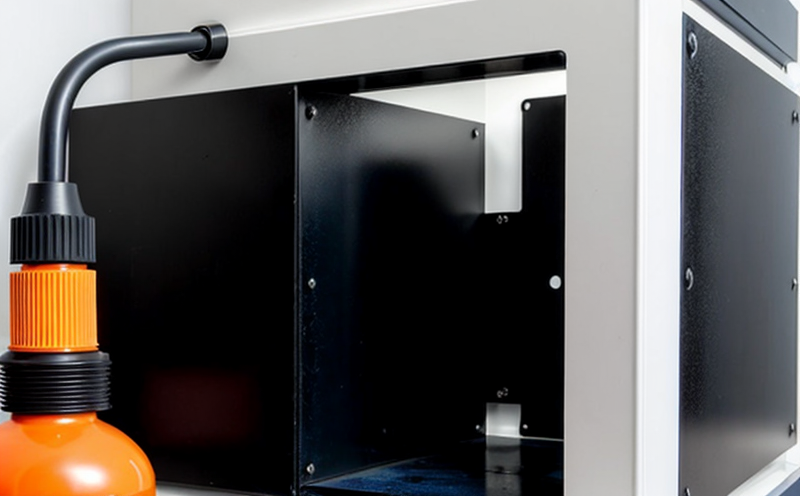DIN 55633 Weathering Resistance of Nanocoatings on Plastics
The DIN 55633 weathering resistance test is a crucial procedure in evaluating the durability and longevity of nanocoatings applied to plastics. This test simulates environmental exposure, particularly sunlight, which can degrade the integrity and performance of coatings over time. Understanding this degradation is essential for ensuring product reliability across various industries such as automotive, electronics, construction, and consumer goods.
Plastics are widely used in applications where they must withstand outdoor conditions due to their lightweight, durability, and cost-effectiveness. However, exposure to ultraviolet (UV) radiation can lead to a photodegradation process that weakens the molecular structure of these materials over time. Nanocoatings provide a protective layer that enhances the resistance against such environmental factors. The DIN 55633 test helps manufacturers assess how effective their nanocoatings are in providing this protection.
The test involves exposing coated plastic specimens to artificial light sources that mimic natural sunlight. This exposure is conducted under controlled conditions, including temperature and humidity levels, to simulate real-world weathering scenarios accurately. By following DIN 55633 standards, laboratories can provide reliable data on the durability of nanocoatings, ensuring compliance with industry regulations and enhancing product performance.
The process begins with selecting appropriate specimens that represent the intended application. Specimens are coated according to manufacturer specifications before being subjected to the weathering test. The test typically involves exposing these specimens to a combination of ultraviolet light and heat for extended periods. Monitoring parameters such as color change, loss of gloss, and physical integrity helps determine the coating's resistance to weathering.
The DIN 55633 standard specifies detailed procedures for conducting this test. It outlines specific requirements for the artificial light sources used in the exposure chamber, including spectral characteristics that closely match natural sunlight. The duration of exposure is also precisely defined based on the expected service life of the product being tested. This ensures consistency and repeatability across different tests.
Following the completion of the test, specimens are carefully evaluated for any changes in appearance or performance. These evaluations include measuring color change using spectrophotometric techniques, assessing surface roughness, and examining overall integrity through visual inspection and mechanical testing. Reporting these results provides valuable insights into the effectiveness of nanocoatings under simulated weathering conditions.
The DIN 55633 test is particularly important for industries relying heavily on outdoor applications where prolonged exposure to sunlight can significantly impact product performance. By adhering to this standard, manufacturers can ensure their products maintain high levels of quality and reliability over extended periods.
| Standard Number | Description |
|---|---|
| DIN 55633 | Weathering Resistance of Nanocoatings on Plastics |
| ISO 4892-1 | Plastics - Part 1: Classification, Preparation and General Test Conditions for the Determination of Weathering Resistance |
| ASTM G151 | Determination of UV Weathering Resistance Using Fluorescent Lamps |
| EN ISO 4892-3 | Plastics - Part 3: Test Methods for Determination of Weathering Resistance in Indoor Applications |
Why Choose This Test
The DIN 55633 test is essential for several reasons, primarily due to its rigorous and standardized approach to evaluating the durability of nanocoatings on plastics. It provides a comprehensive assessment of how well these coatings withstand environmental factors such as UV radiation, which can significantly impact product performance over time.
One key advantage of this test lies in its ability to simulate real-world conditions accurately. By using artificial light sources that closely replicate natural sunlight, the DIN 55633 standard ensures that the results obtained are relevant and applicable to actual field use. This level of accuracy is critical for manufacturers who need reliable data to guide product development and quality assurance processes.
The test also offers a structured methodology for conducting weathering resistance evaluations, ensuring consistency across different laboratories. This standardization allows for easier comparison of results between various studies and facilitates industry-wide acceptance. Furthermore, by adhering to DIN 55633 standards, manufacturers can demonstrate compliance with international regulations and best practices, enhancing their reputation in the market.
Another significant benefit is its versatility. The test can be tailored to suit different types of nanocoatings and plastic substrates, making it suitable for a wide range of applications across various industries. Whether you're developing new coatings or validating existing ones, DIN 55633 provides a robust framework for assessing their performance under harsh environmental conditions.
Finally, the DIN 55633 test offers valuable insights into the long-term behavior of nanocoatings on plastics. By monitoring changes in color, gloss, and physical properties over time, it helps identify potential weaknesses or areas for improvement. This information is invaluable for continuous product enhancement and innovation.
International Acceptance and Recognition
The DIN 55633 weathering resistance test enjoys widespread acceptance and recognition globally, particularly in Europe but also beyond. Its rigorous methodology and standardized approach have earned it a reputation as a reliable benchmark for evaluating the durability of nanocoatings on plastics.
In addition to its European origins, the standard is increasingly adopted internationally due to its comprehensive nature and relevance across various industries. Many countries recognize DIN 55633 as an authoritative source for assessing weathering resistance, which contributes to its growing global influence.
The international acceptance of DIN 55633 extends beyond mere recognition; it also fosters collaboration and standardization within the industry. By adhering to this standard, manufacturers can ensure their products meet stringent quality standards regardless of geographical location. This harmonization of testing methods facilitates easier trade and cooperation between different regions.
The widespread adoption of DIN 55633 reflects its value in promoting product reliability and consistency across diverse applications. Its global recognition underscores the importance of this test in ensuring that nanocoatings on plastics perform reliably under various environmental conditions.





